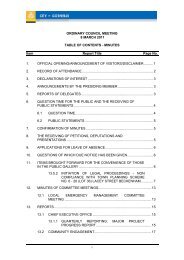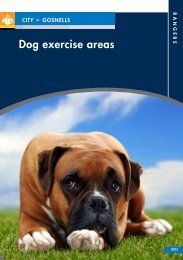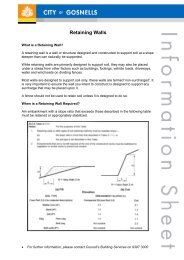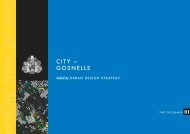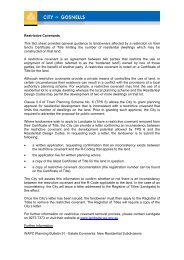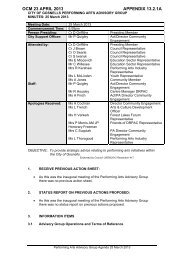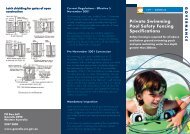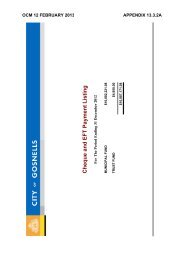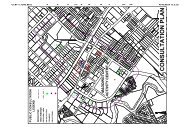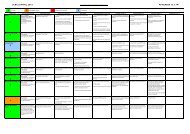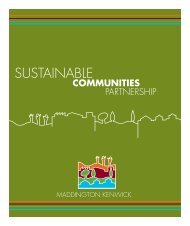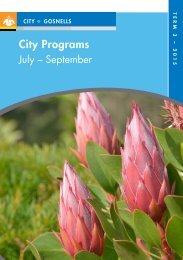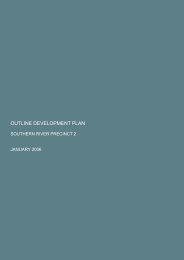Summary - City of Gosnells
Summary - City of Gosnells
Summary - City of Gosnells
You also want an ePaper? Increase the reach of your titles
YUMPU automatically turns print PDFs into web optimized ePapers that Google loves.
Flora 441. Taxa <strong>of</strong> scarce or refugial habitatsMost <strong>of</strong> the regionally significant taxa in the MKSEA are plants whose habitats on the SCP have beenreduced to the status <strong>of</strong> remnants or small refuges. These habitats in the MKSEA include:a. Muchea Limestone habitats in Precincts 2 and 3B. These habitats had the following species:Burchardia bairdiae, Comesperma cf. polygaloides, Dielsia stenostachya, Dodonaea ceratocarpa,Eucalyptus decipiens, Eucalyptus gomphocephala, Gahnia trifida, Gastrolobium ebracteolatum,Hakea ceratophylla, Lawrencia squamata, Melaleuca brevifolia, Prasophyllum drummondii,Samolus junceus, Sphaerolobium vimineum, Thysanotus arenarius, Tricoryne aff. elatior andWilsonia backhousei.b. Floodplains <strong>of</strong> Yule Brook. Although these wetlands have been degraded in many areas and theirecological functions have been somewhat disturbed, a number <strong>of</strong> regionally significant taxa havepersisted on the levee banks and floodplains <strong>of</strong> this watercourse in the MKSEA. These taxa includeMelaleuca osullivanii, Thysanotus dichotomus and Trymalium odoratissimum subsp.odoratissimum.c. Muddy sand palusplains were most prevalent in Precinct 2 <strong>of</strong> the MKSEA and were host to thelargest group <strong>of</strong> regionally significant taxa in the MKSEA. These taxa include Acanthocarpuscanaliculatus, Anigozanthos viridis subsp. viridis, Borya scirpoidea, Burchardia multiflora,Calothamnus hirsutus, Chaetanthus aristatus, Conostylis festucacea subsp. festucacea,Cytogonidium leptocarpoides, Dichopogon preissii, Drosera bulbosa subsp. bulbosa, Droseramenziesii subsp. menziesii, Drosera tubaestylis, Gastrolobium capitatum, Isotoma scapigera,Grevillea bipinnatifida subsp. bipinnatifida, Hypocalymma angustifolium Mud Habitats Variant,Kunzea micrantha subsp. micrantha, Melaleuca lateriflora subsp. acutifolia, Mesomelaenatetragona, Neurachne alopecuroidea, Hakea sulcata, Petrophile juncifolia, Philydrella pygmaeasubsp. pygmaea, Pimelea imbricata var. major, Pogonolepis stricta, Scaevola lanceolata, Schoenusasperocarpus, Schoenus elegans, Schoenus odontocarpus, Schoenus plumosus, Schoenusvariicellae, Schoenolaena juncea, Stylidium roseoalatum, Thelymitra antennifera, Tremulinatremula, Tribonanthes brachypetala, Triglochin muelleri, Verticordia acerosa var. preissii,Verticordia plumosa var. brachyphylla and Wurmbea dioica subsp. alba.d. Muddy sumplands (claypans) and floodplains were located in Precincts 2 and 3B and had a number<strong>of</strong> aquatic or emergent taxa that are regionally significant, including Amphibromus nervosus,Chorizandra enodis, Melaleuca lateritia, Utricularia inaequalis, Utricularia multifida, Villarsiacapitata and Wurmbea dioica subsp. Brixton (G.J. Keighery 12803).e. Dunes <strong>of</strong> Bassendean Sands over the Guildford Formation were located in Precincts 1 and 2.Regionally significant taxa in these habitats are Cyathochaeta equitans and Dasypogonobliquifolius.2. Significant PopulationsMany <strong>of</strong> the taxa in the MKSEA that are regionally significant for other reasons also formed large,healthy, resilient populations in this area despite the stresses on these small wetland remnants. Thesetaxa include Acacia lasiocarpa var. lasiocarpa sens. strict., Actinostrobus pyramidalis, Banksiatelmatiaea, Gahnia trifida, Goodenia pulchella subsp. Coastal Plain B (M.Hislop 634) p.n.,Hypocalymma angustifolium Mud Habitat Variant (C. Tauss 1850), Melaleuca brevifolia, Melaleucalateriflora subsp. acutifolia, Pimelea imbricata var. major and Thysanotus arenarius.3. Geographical RangeThe MKSEA has a large group <strong>of</strong> taxa that are at, or near to, the ends <strong>of</strong> their natural geographicalranges or have populations in this area disjunct from their main ranges. These taxa are Anarthria laevis,Anigozanthos manglesii x bicolor, Banksia telmatiaea, Boronia crenulata subsp. viminea, Cytogonidiumleptocarpoides, Hakea ceratophylla, Lawrencia squamata, Leucopogon strictus, Pimelea imbricata var.major, Podolepis capillaris, Prasophyllum drummondii, Schoenus elegans and Schoenus subflavussubsp. subflavus.Tauss, C. and Weston, A.S. (2010). The flora, vegetation and wetlands <strong>of</strong> the Maddington-Kenwick Strategic Employment Area.A survey <strong>of</strong> the rural lands in the vicinity <strong>of</strong> the Greater Brixton Street Wetlands. Report to the <strong>City</strong> <strong>of</strong> <strong>Gosnells</strong>, W.A. Version 18.04.10



